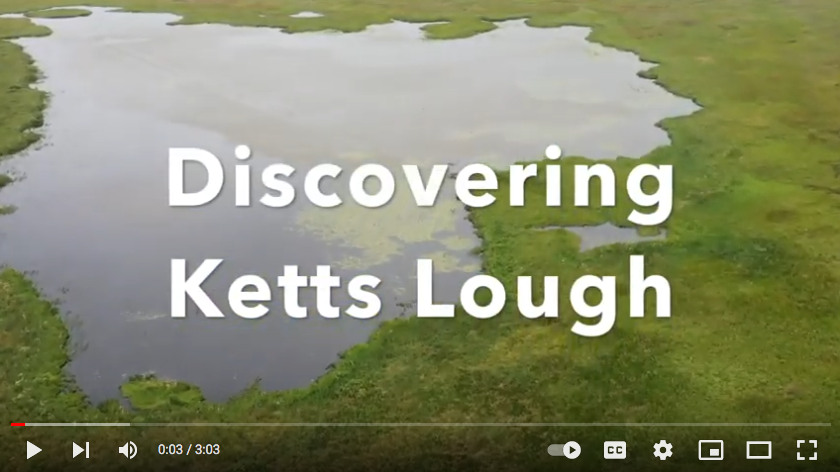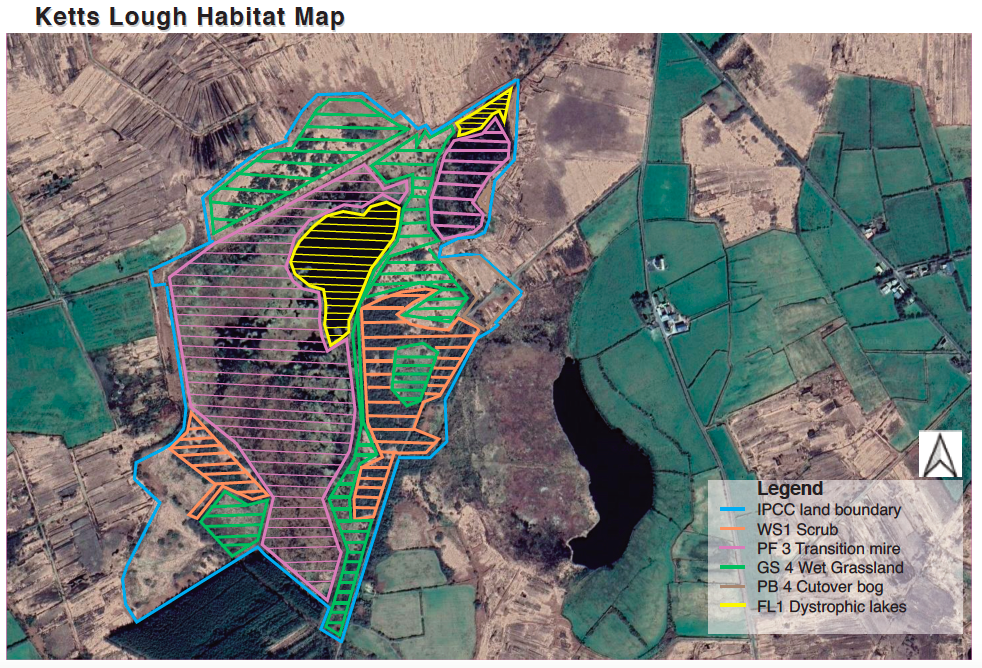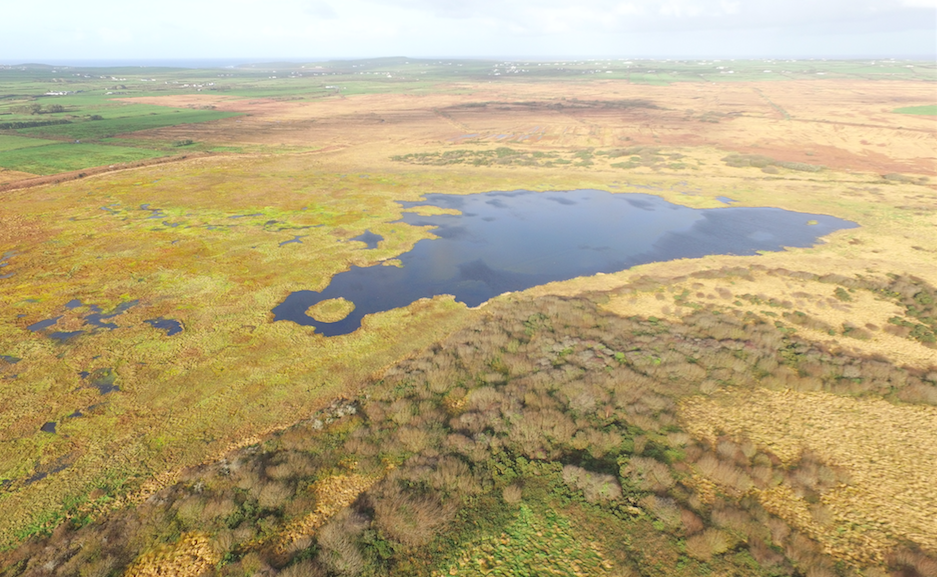 Ketts Lough, Co. Clare. Image courtesy of Wetlands Survey Ireland taken during an unmanned aerial vehicle (UAV) survey in mapping wetland habitats for Tullaher Lough and Bog SAC, County Clare on behalf of the National Parks and Wildlife Survey, Department of Culture, Heritage and the Gaeltacht, 2017.
Ketts Lough, Co. Clare. Image courtesy of Wetlands Survey Ireland taken during an unmanned aerial vehicle (UAV) survey in mapping wetland habitats for Tullaher Lough and Bog SAC, County Clare on behalf of the National Parks and Wildlife Survey, Department of Culture, Heritage and the Gaeltacht, 2017.
- Area: 63.12 hectares
- County: Clare
- Bogland Type: Transition Mire
- Designation: Located within the Tullaher Lough and Bog SAC (002343)
- Year Acquired by IPCC: 2021
- Co-ordinates: 52.702263, -9.555755
- Access: Due to the extremely wet nature of Ketts Lough there is no visitor access available. To help you discover and explore Ketts Lough IPCC have prepared a short video for you to watch.
The IPCC can accept no liability for injury to persons visiting the site.
Share your Ketts Lough discovery with friends and family using IPCC’s Discovering Ketts Lough poster or Ketts Lough Leaflet
What is a transition mire?
Ketts Lough is an example of a transition mire. Described by Julie A. Fossitt within the Guide to the Habitats of Ireland a transition mire is an unstable peat-forming community that develops on the surface of water where there is a small to medium influx of nutrients and where floating mats of vegetation typically occur over saturated or open water. A transition mire may occupy a transitional zone between bog and fen vegetation, such as on the margin of a raised bog known as a lagg zone. It may also occur where groundwater flows through deep peat or the transition stage between a groundwater-fed fen and a rainwater-fed bog. According to the Status of EU Protected Habitats and Species in Ireland, the overall status of transition mires in Ireland is bad.
Habitats of Ketts Lough
In 1991 Irish Peatland Conservation Council staff Peter Foss and Catherine O’Connell surveyed Ketts Lough and identified a number of habitats. The results of this survey were included within the 2017 Unmanned Aerial Vehicle (UAV) Survey in Mapping Wetland Habitats by Wetlands Survey Ireland conducted on behalf of the National Parks and Wildlife Service.
A large open body of water occurs at the northern end of Ketts Lough which is relatively shallow. The substrate in the lake is a mineral rich gritty clay. Emergent plants present over the surface of the lake included Menyanthes trifoliata (Bogbean) and Carex rostrata (Bottle sedge). The vegetation around the lake shore is species rich and occurred in approximately 20 – 30 cm of water. Beyond the immediate lakeshore vegetation, larger areas of sedge vegetation occur, though Typha latifolia (Bulrush) was only sparsely present in 1 or 2 small stands to the west of this open water. To the south of the open water body small sedge vegetation with Equisetum fluviatile (Horsetail) is the main community present. Menyanthes trifoliata formed mono-dominant stands in parts while some open water channels contained Nuphar lutea (Yellow water-lily). All these areas form quaking mats of vegetation. As one moves south and north of the lake the vegetation becomes less aquatic in nature and more ombrotrophic until one is in Eriophorum (Cotton grass) and Sphagnum dominated vegetation. There is evidence today of past turf cutting in these ombrotrophic areas surrounding Ketts Lough.
Flora & Fauna of Ketts Lough
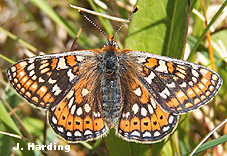 Ketts Lough is a diverse habitat offering flora and fauna an important habitat to breed, feed and take shelter. Two species of note recorded on the site include the Marsh Fritillary butterfly and the Greenland White Fronted Goose. The Marsh Fritillary butterfly (Euphydryas aurinia) Irelands only insect listed within Annex II of the European Habitats Directive feeds on Devils’s Bit Scabious located in the drier grassy areas surrounding Ketts Lough.
Ketts Lough is a diverse habitat offering flora and fauna an important habitat to breed, feed and take shelter. Two species of note recorded on the site include the Marsh Fritillary butterfly and the Greenland White Fronted Goose. The Marsh Fritillary butterfly (Euphydryas aurinia) Irelands only insect listed within Annex II of the European Habitats Directive feeds on Devils’s Bit Scabious located in the drier grassy areas surrounding Ketts Lough. 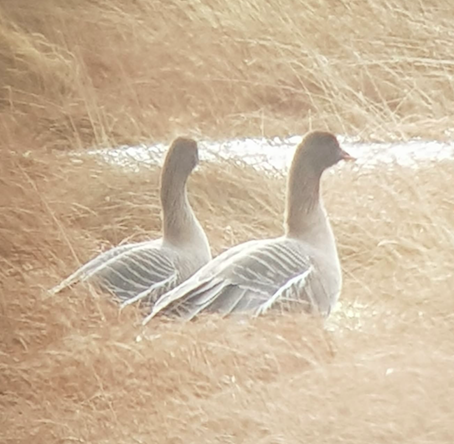 A small population of Greenland White Fronted Geese (Anser albifrons flavirostris), image courtesy of WestClare Wildlife Club, annually visit Ketts Lough between October and April. This bird does not breed in Ireland it spends its time here feeding on a range of plant material taking roots, tubers, shoots and leaves. This bird is sadly scarce in Ireland today and its presence supports the selection of sites as a conservation interest for a number of Special Protection Area’s in Ireland. Other wild fauna recorded on Ketts Lough include, but not limited to, Hare (Lepus timidus hibernicus) and Kestrel (Falco tinnunculus).
A small population of Greenland White Fronted Geese (Anser albifrons flavirostris), image courtesy of WestClare Wildlife Club, annually visit Ketts Lough between October and April. This bird does not breed in Ireland it spends its time here feeding on a range of plant material taking roots, tubers, shoots and leaves. This bird is sadly scarce in Ireland today and its presence supports the selection of sites as a conservation interest for a number of Special Protection Area’s in Ireland. Other wild fauna recorded on Ketts Lough include, but not limited to, Hare (Lepus timidus hibernicus) and Kestrel (Falco tinnunculus).
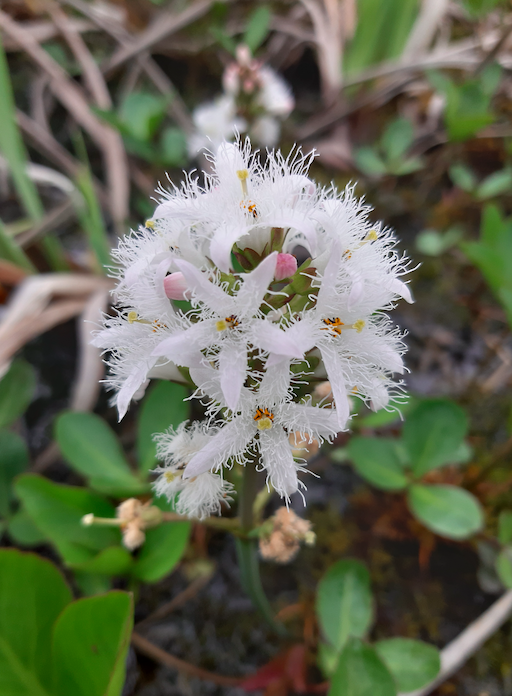 With habitats present ranging from open water lake to ombrotophic peatland Ketts Lough does not disappoint in terms of the wild flora recorded on the site. Menyanthes trifoliata (Bogbean) is dominant in areas while carpets of Vaccinium oxycoccos (Cranberry) offer a rich supply of berries to wildlife. In the ombrotrophic areas of the site typical peatland flora including Ling Heather (Calluna vulgaris), Common Cottongrass (Eriophorum angustifolum) and Sphagnum species are present.
With habitats present ranging from open water lake to ombrotophic peatland Ketts Lough does not disappoint in terms of the wild flora recorded on the site. Menyanthes trifoliata (Bogbean) is dominant in areas while carpets of Vaccinium oxycoccos (Cranberry) offer a rich supply of berries to wildlife. In the ombrotrophic areas of the site typical peatland flora including Ling Heather (Calluna vulgaris), Common Cottongrass (Eriophorum angustifolum) and Sphagnum species are present.
Children’s Burial Ground
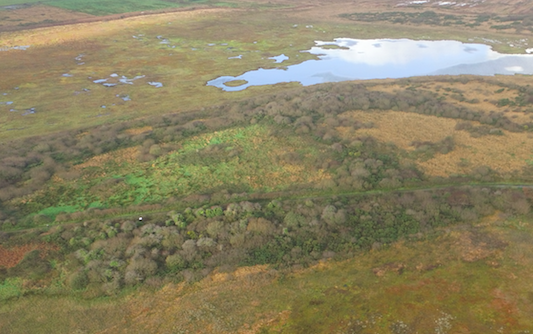 Image courtesy of Wetlands Survey Ireland.
Image courtesy of Wetlands Survey Ireland.
Children’s burial grounds also known as Cilliní are the designated resting places of unbaptised children in Ireland. Recorded within the National Monuments Historic Environment Viewer a children’s burial ground rests within Ketts Lough, reference CL056-027. This site described by Mary Tunney in 2016 is situated on a gentle South facing slope . A slightly raised, roughly circular area (17m North-South; 18m East-West; 0.45-0.6m above surrounding ground level) surrounded by rushes. A circular central area (diametre 5m) is slightly higher than the rest and is heavily overgrown. It contains one upright grave marker (maximum height 0.4m) and two smaller ones. Some very low stone grave markers were noted by Ms Tunney under the grass cover through the remainder of the site. It is thought the children’s burial ground at Ketts Lough dates to the 1918 influenza pandemic. In 2022 Clare County Council are undertaking a survey of children’s burial grounds in Co. Clare with the burial ground at Ketts Lough included within the survey.
Thank You to Our Supporters
The purchase and conservation of Ketts Lough was made possible with funds raised through IPCC’s Sale of Symbolic Shares in Irish peatland initiative. Thank you to all those individuals and businesses who donated to this fund, you have ensured the conservation of this wetland habitat, which offers a variety of ecosystem services to us all, for people today and future generations.
![]() IPCC would also like to acknowledge and thank the Heritage Council who funded a project entitled ‘Discovering Ketts Lough’ through their Community Grant Scheme 2022.
IPCC would also like to acknowledge and thank the Heritage Council who funded a project entitled ‘Discovering Ketts Lough’ through their Community Grant Scheme 2022.
Contact Us
The Irish Peatland Conservation Council can be contacted at the Bog of Allen Nature Centre, Lullymore, Rathangan, Co. Kildare R51 V293, Ireland. Tel: +353-45-860133; Email: bogs@ipcc.ie

